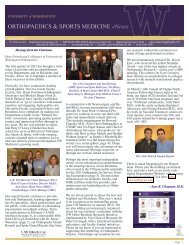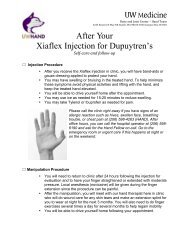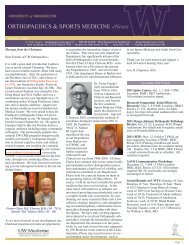2002 - University of Washington Bone and Joint Sources
2002 - University of Washington Bone and Joint Sources
2002 - University of Washington Bone and Joint Sources
Create successful ePaper yourself
Turn your PDF publications into a flip-book with our unique Google optimized e-Paper software.
90<br />
80<br />
70<br />
60<br />
50<br />
40<br />
30<br />
20<br />
10<br />
0<br />
90<br />
80<br />
70<br />
60<br />
50<br />
40<br />
30<br />
20<br />
10<br />
0<br />
Figure 2: Preoperative <strong>and</strong> postoperative SF-36 scores for total shoulder arthroplasty compared to<br />
weighted means for total hip arthroplasty reported in the literature.<br />
general health perception). These<br />
differences were statistically significant.<br />
After the surgery, although the amount<br />
<strong>of</strong> difference was much smaller, the<br />
scores for patients were still lower than<br />
population controls for most SF-36<br />
dimensions (Figure 1). Preoperatively,<br />
TSA patients scored higher than THA<br />
patients on all SF-36 dimensions.<br />
Postoperatively, there was little<br />
difference between the TSA <strong>and</strong> the<br />
THA patients (Figure 2). Similarly, the<br />
TSA patients scored higher than the<br />
CABG patients in all SF-36 dimensions<br />
TSA pre-op<br />
TSA post-op<br />
THA pre-op<br />
THA post-op<br />
TSA pre-op<br />
TSA post-op<br />
CABG pre-op<br />
CABG post-op<br />
Figure 3: Preoperative <strong>and</strong> postoperative SF-36 scores for total shoulder arthroplasty compared to<br />
weighted means for coronary bypass graft procedures reported in the literature.<br />
preoperatively. After surgery, the TSA<br />
patients scored better or equal to the<br />
CABG patients (Figure 3).<br />
DISCUSSION<br />
The patients in this study<br />
experienced significant improvements<br />
in their health- related quality <strong>of</strong> life<br />
following TSA for glenohumeral<br />
osteoarthritis. These improvements in<br />
multiple dimensions <strong>of</strong> the SF-36 were<br />
durable, since these gains were<br />
documented between 30 <strong>and</strong> 60<br />
months postoperatively. This study also<br />
documents the diminished quality <strong>of</strong><br />
life <strong>of</strong> individuals coming to surgery for<br />
glenohumeral osteoarthritis. In six out<br />
<strong>of</strong> eight SF-36 dimensions, the<br />
preoperative SF-36 scores for these<br />
patients was significantly lower than<br />
that <strong>of</strong> age- <strong>and</strong> gender-matched<br />
population controls. These scores<br />
improved after surgery, but did not<br />
reach the levels found in the control<br />
population (Radosevich et al, 1994).<br />
As increasing attention is focused<br />
on health care costs, the value <strong>of</strong><br />
surgical interventions to the patient <strong>and</strong><br />
the relative value <strong>of</strong> these procedures<br />
need to be well documented. In this<br />
spirit, we compared the changes in<br />
patient health status following TSA to<br />
the previously reported changes in<br />
quality <strong>of</strong> life following total hip<br />
arthroplasty, which is considered to be<br />
a very effective procedure. We observed<br />
that the SF-36 scores for patients with<br />
arthritis <strong>of</strong> the hip were lower than<br />
those <strong>of</strong> patients with shoulder<br />
arthritis. Postoperatively, both<br />
reconstructive procedures (total<br />
shoulder <strong>and</strong> total hip) demonstrated<br />
a similar effectiveness in improving<br />
quality <strong>of</strong> life.<br />
We also compared our results to<br />
another chronic medical condition<br />
which affects patients <strong>of</strong> a similar age,<br />
<strong>and</strong> for which the surgical solution is<br />
generally believed to be very effective:<br />
coronary artery bypass graft surgery.<br />
Patients with shoulder osteoarthritis<br />
appeared to score generally lower on the<br />
comfort score than those patients with<br />
chronic angina. In the other six healthrelated<br />
quality <strong>of</strong> life dimensions<br />
however, the patients with<br />
glenohumeral osteoarthritis tended not<br />
to score as low as the chronic angina<br />
patients did preoperatively.<br />
Postoperatively however, the total<br />
shoulder patients, <strong>and</strong> the CABG<br />
patients were brought up to similar<br />
levels for all eight SF-36 dimensions.<br />
In conclusion, this study has shown<br />
that total shoulder arthroplasty can<br />
improve the quality <strong>of</strong> life in patients<br />
with glenohumeral osteoarthritis<br />
several years after surgery.<br />
Postoperative SF-36 scores were lower<br />
than the control population, but they<br />
were similar to those previously<br />
reported for other effective orthopaedic<br />
<strong>and</strong> cardiac procedures.<br />
36 <strong>2002</strong> ORTHOPAEDIC RESEARCH REPORT















